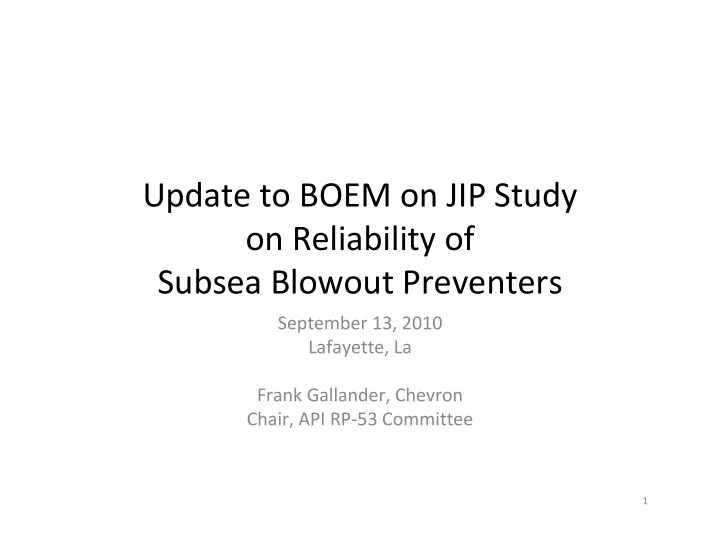

Update to BOEM on JIP Study on Reliability of Subsea Blowout Preventers September 13, 2010 Lafayette, La Frank Gallander, Chevron Chair, API RP ‐ 53 Committee 1
Reliability of Subsea Blowout Preventers • JIP Study commissioned in April 2007 • This study examined the historical reliability of . subsea well control systems, operating in the Gulf of Mexico (GOM) • Reviewed all subsea wells drilled during the three ‐ year period (January 1, 2004 ‐ December 31, 2006) • Final subsea report issued May 12, 2009 2
Reliability of Subsea Blowout Preventers • First reliability based study since 1996 and 1999 (Tetrahedron & SINTEF respectively) • Included the largest number of 5 th & 6 th generation rigs • Industry’s first statistically based study at the component and system levels 3
RESULTS OF SUBSEA BOP RELIABILITY Equipment Probability of Success: 99%+ 4
RESULTS OF SUBSEA BOP RELIABILITY Equipment Failure Frequency 5
RESULTS OF SUBSEA BOP RELIABILITY Total Number of MMS Subsea Wells • 239 Distribution of Failures from Subsea BOP Reliability Study Total Number of Wells Recorded • 238 Total Number of Test Records • 4 ,244 Total Number of Failures Recorded • 62 Average Regulatory Tests Per Well • 21 Total Number of Component Tests • 89,189 Average component Tests per Well • 375 Confidence Factor of the data • 99.58% (Goal of 95%) 6
RECOMMENDATIONS TO MMS 1) Clarify § 250.449 (c) to clearly define that testing all possible redundant control possibilities is not required. 2) Clarify § 250.449 (h) to explicitly state that wellbore pressure testing also satisfies regulatory requirements of function testing. 3) Modify § 250.447 to incorporate: (b) maximum BOP wellbore pressure test interval of 35 days (c) limit BOP wellbore pressure testing before drilling out each string of casing or a liner to those identified in the APD. 4) Modify § 250.449 as follows: (d) pressure test BSR only at points designated and approved in the APD, (e) change the maximum interval between any blind or blind ‐ shear ram BOP pressure tests from 30 to 77 days. 5) MMS issue a safety alert describing pressure de ‐ rating of annulars fitted with large bore drill pipe elements. 7
RECOMMENDATIONS TO API API RP ‐ 53; Recommended Practices for Blowout Prevention Equipment Systems for Drilling Wells : 1) Update Figures 4 and 5 describing minimum stack requirements. 2) Specific issues for discussion: a. Provide additional details for testing of the hydraulic operating system to more closely replicate conditions subsea. b. Provide a protocol for testing spring and stem integrity on stack valves. 3) Change: a. the recommended maximum time between wellbore pressure tests in 18.3.3.c to 35 days and that all crews are properly trained to conduct said wellbore pressure tests, b. 18.5.9 to specify conducting locks only ram wellbore pressure tests for every stump test, as well as, a discussion on the risks and preventative measures to minimize risks during locks only testing. 4) Adding the following to 18.3.1 Ensure Emergency Disconnect System and Deadman systems, if installed, are tested while latched on a subsea wellhead, at least initially after a rig comes out of the shipyard. API 16A; Specifications for Drill Through Equipment : 1) Adding locks only pressure testing rams every 500 psi in the qualification tests listed in 5.7. 2) Increasing API fatigue testing for ram locking systems listed in Appendix C2.2 by dramatically increasing the number of locking cycles. 8
Current API Initiatives Working to update RP ‐ 53, 16A and 16D. • API RP ‐ 53 and API Sub ‐ Committees 16A and 16D (Specification for Control Systems for Drilling Well Control Equipment and Control Systems for Diverter Equipment) have reconvened • RP ‐ 53 committee has broad industry participation (BOEM invited). • Documents under review for content Dept of Interior 30 Day Report (May 27, 2010) NTL ‐ 2010 ‐ 05 & 06 JIP Study Recommendations Final reports of the several Deepwater Horizon investigations 9
API Recommended Practices and Specifications Focus Areas • Stack configurations • Clear definitions • Standardizations within the industry • Results from Deepwater Horizon Investigations, as they are made available to the public 10
Recommend
More recommend